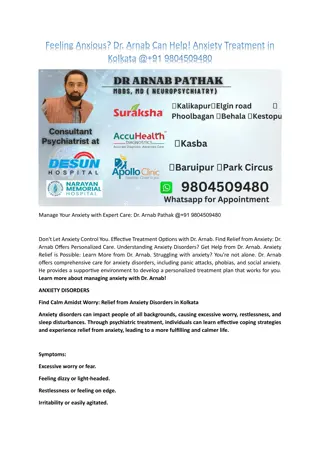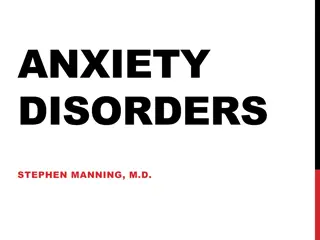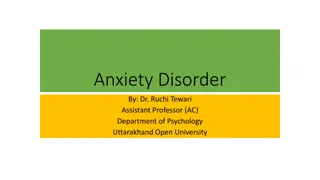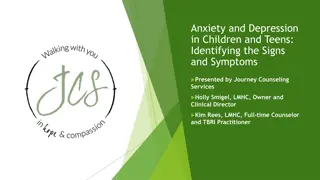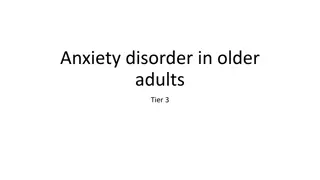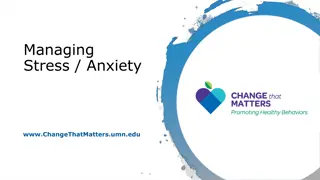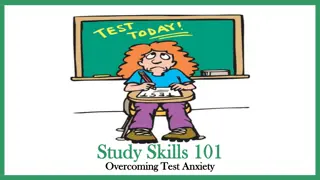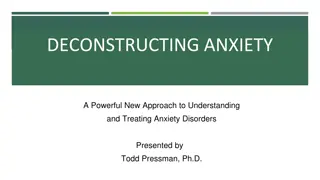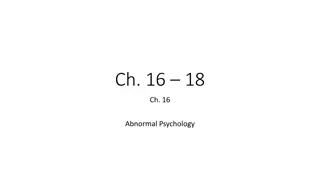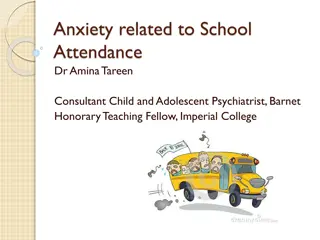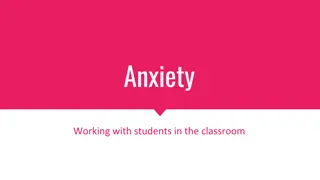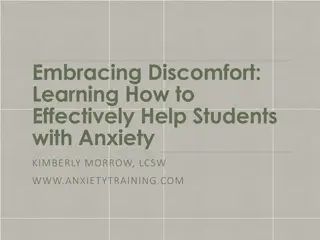Understanding Anxiety in Youth: Causes, Symptoms, and Disorders
Anxiety in youth is a natural response but can become problematic when experienced excessively. Learn about the anxiety triad response, false alarms, common anxiety disorders, separation anxiety disorder, generalized anxiety disorder, and common elements of these disorders.
Uploaded on Oct 05, 2024 | 0 Views
Download Presentation

Please find below an Image/Link to download the presentation.
The content on the website is provided AS IS for your information and personal use only. It may not be sold, licensed, or shared on other websites without obtaining consent from the author. Download presentation by click this link. If you encounter any issues during the download, it is possible that the publisher has removed the file from their server.
E N D
Presentation Transcript
ANXIETY IN YOUTH Greta Francis, PhD, ABPP February 5, 2020
ANXIETY AS A NATURAL RESPONSE An internal alarm system when danger is present A motivator
ANXIETY TRIAD RESPONSE Fight Flight Freeze COMPONENTS Thoughts Physical reactions Actions
FALSE ALARMS Responding with anxiety when there is no actual danger Becomes a problem when It happens a lot It feels intense and upsetting It keeps you from doing important and/or necessary things
FALSE ALARM EXAMPLE A 10thgrader is anxious about field hockey tryouts She thinks she isn t good enough to make the team Her muscles are tight and she has butterflies in her stomach She might Pick a fight with her mom to avoid going to the tryout Call her grandfather to pick her up early Feel like her mind goes blank and she is frozen when her turn comes up
ANXIETY AND DEVELOPMENT Preschool and younger Separation Elementary school Pretend things, the dark Middle school Natural disasters, making friends High school Social fears
COMMON ANXIETY DISORDERS IN YOUTH Separation Anxiety Disorder Generalized Anxiety Disorder Social Anxiety Disorder Phobias
COMMON ELEMENTS OF DISORDERS Distress Persistence Impairment
SEPARATION ANXIETY DISORDER Unrealistic fear of being separated Unrealistic fear of harm to caregiver Distress upon, or in anticipation of, separation Physical complaints upon separation Nightmares involving separation Reluctance/refusal to leave caretakers Reluctance/refusal to be alone or to sleep alone
GENERALIZED ANXIETY DISORDER Excessive worry/anxiety about multiple things Difficulty controlling the worry/anxiety At least one of the following Feeling restless or on edge Feeling easily fatigued Mind goes blank Irritability Muscle tension Sleep difficulties
SOCIAL ANXIETY DISORDER Comparison is the thief of joy (T. Roosevelt) Fear of social situations involving being scrutinized by others Social interaction Being observed Performing Fear of acting in a way that will be embarrassing Avoidance of social situations
PHOBIAS Fear of a specific object or situation Avoids or endures with intense fear Fear is out of proportion to the actual danger Many types
SCHOOL PHOBIA Not an actual diagnosis At worst, may involve complete avoidance of attending school Often a result of a particular anxiety disorder
NATURAL INSTINCT OF CAREGIVERS Desire to protect Provide reassurance to an anxious child The intention is to help that child feel better
ACCIDENTAL ACCOMMODATION When your intention to help an anxious child actually contributes to that child becoming more anxious over time Accommodation can occur when we provide reassurance and/or remove expectations
HOW ACCOMMODATION CAN HAPPEN We intend to help We believe that anxiety is dangerous We need to get something done now We are anxious ourselves
EXAMPLES OF ACCOMMODATION Parents call the babysitter to cancel their plans to go out Grandparent picks their grandchild up early from school so that the grandchild doesn t have to do the oral report in history class Teacher lets the student stay inside for recess every day instead of going outside to play with peers
WHATS THE MESSAGE? This is way too dangerous! You will not be ok. You will not be able to handle this.
GENERAL APPROACH TO TREATMENT Improve coping Improve distress tolerance Gradual experiential learning to decrease avoidance
WHAT CAN CARING ADULTS DO? Address accidental accommodation Be mindful of the message Model coping and distress tolerance Encourage and support coping and distress tolerance Encourage and support approach rather than avoidance
EXAMPLE: TX OF SOCIAL ANXIETY 9thgrade girl with social anxiety disorder and mild IBS Avoidance Accommodation Treatment
EXAMPLE: TX OF SEPARATION ANXIETY 1stgrade boy with separation anxiety disorder Avoidance Accommodation Treatment
COLLABORATION WITH SCHOOLS The only place outside of home that a child really has to go is school Many youth with anxiety disorders show symptoms in (or about) school Often the key to successful treatment is collaboration between the child, family, outpatient treatment providers, and school personnel



